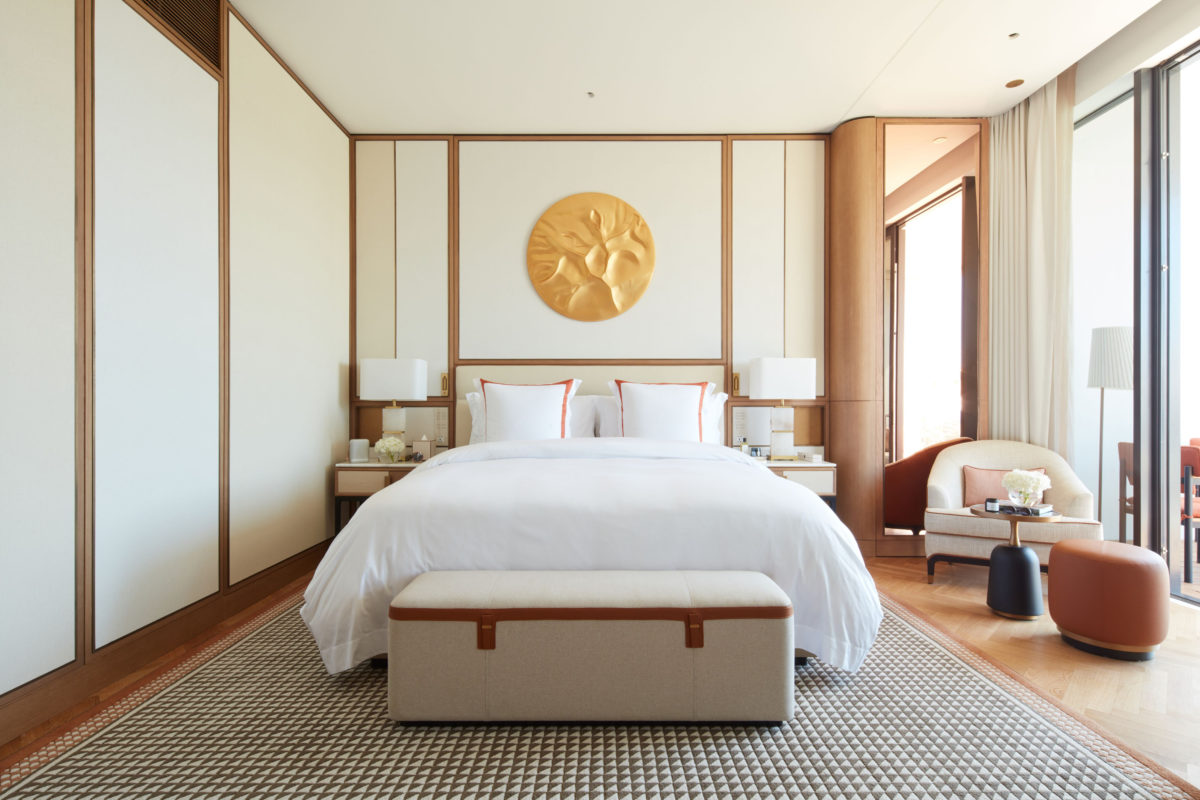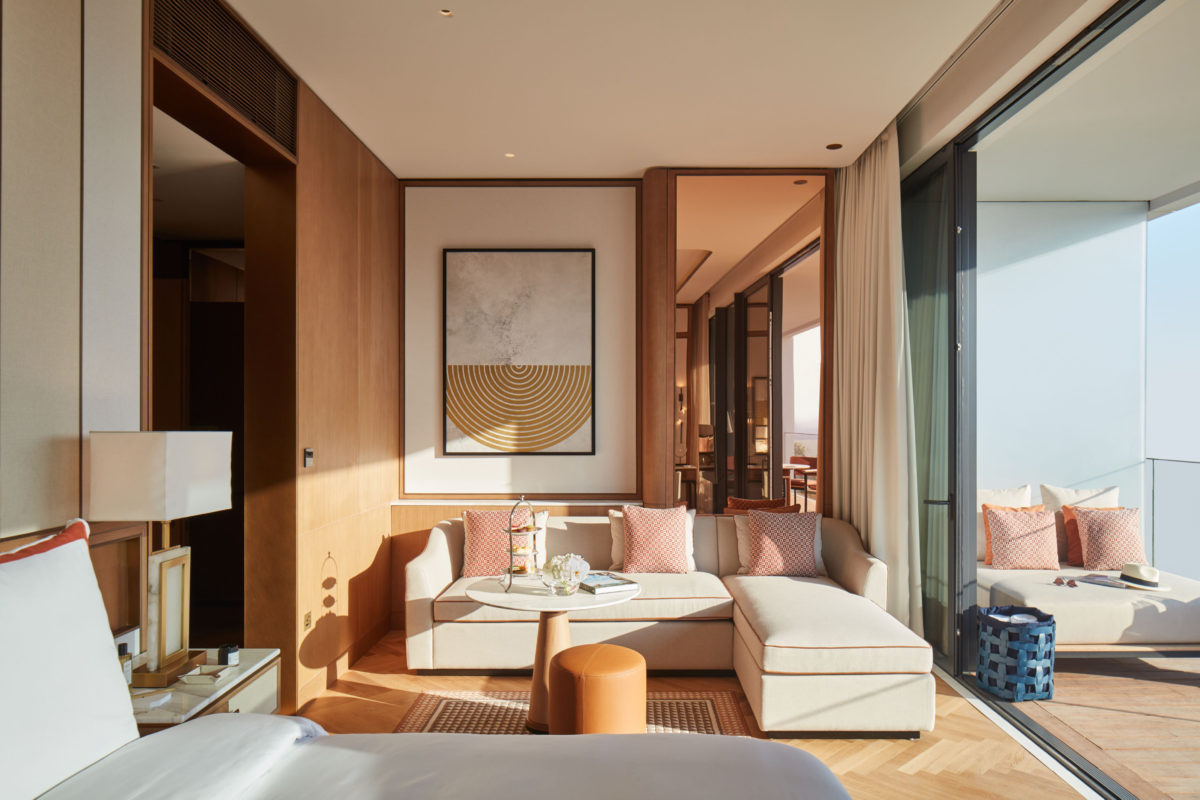By John O’Ceallaigh
It looks like the time could soon come when Dubai’s Burj Al Arab will no longer be Jumeirah’s flagship hotel. When I spoke to Jumeirah CEO José Silva and senior members of his team recently, excitement about the launch of their forthcoming Jumeirah Marsa Al Arab was palpable. José told me that the pandemonium of the pandemic did at least give his team time to ‘jumpstart the brand for the 21st century’. Opened in 1999, the Burj Al Arab put Jumeirah on the map, but it sounds like Jumeirah Marsa Al Arab, opening in 2023 and within sight of the original landmark, will signpost where the brand wants to go in the future.
A vast, undulating property whose facade was inspired by the superyacht silhouette, Jumeirah Marsa Al Arab will occupy a prime site on the tip of a peninsula on Dubai’s largest private beach. The resort will incorporate 390 rooms, suites and penthouses, every one with four-metre-high ceilings and many featuring 11-metre-wide floor-to-ceiling windows. Wherever guests stay, they’ll be able to look out at the Arabian Sea. Renderings I saw of the rooms (with many of the shots not to be released for public view for some time) show beautifully calm, restful interiors in caramel, cream and brown.
The shots made me want to stay there, and those rooms will also be a far cry from the gold and purple suites you might find in the Burj Al Arab, where mirrors are suspended over the beds. (For what it’s worth, those interiors weren’t to my personal taste, but I was won over by the service and food when I stayed at the Burj Al Arab a few years back, and I do understand why some people love it – if you sign up to stay in that type of property then it delivers what you’ll expect.)
Back at Jumeirah Marsa Al Arab, guests will have access to four pools, including an infinity pool for families and a panoramic pool placed within the resort’s three-storey, 3,500 square metre spa and fitness area. There will also be 10 restaurants and bars designed by internationally acclaimed restaurant designers. I was told that four of these will be placed in a food court-style setting, and will operate concurrently during breakfast so guests can try drastically different menus each morning. The resort will also be enfolded by landscaped private gardens, featuring secluded cabana areas and pavilions.



Jumeirah Marsa Al Arab was designed by Dubai-based Shaun Killa, whose practice has long worked in the emirate. He was most notably involved with the development of the Burj Al Arab. Responsible for the look of the building’s interiors is French designer Tristan Auer, in association with Wilson Associates. The resort will be the centrepiece of a broader development by Dubai Holding, which will span more than 160,000 square metres of reclaimed land and which will include a number of six-bedroom marina villages and an 83-berth superyacht marina and boardwalk.
With development ongoing, rates for the property have yet to be decided, but I was told they might even surpass those of the neighbouring Burj Al Arab. To stay at that hotel this month will cost you a minimum of £1,029 per night; in January, rates will start from £926.
Jumeirah’s portfolio currently numbers 24 properties, but José Silva has high expectations for the brand in the years to come. He told me: “We’re going global, but beyond just growing globally we want to elevate the brand. Whereever we go, we want Jumeirah to be an expression of the excellence of Dubai, and of the Middle East.” His expectation is that the group will add between one and three properties to its portfolio over the coming years, and his team are keen to open a ski resort, perhaps in the French Alps, alongside addresses in the Mediterranean and cities such as Paris and Rome.
An indication of Jumeirah’s future ambitions can be seen at the revamped Carlton Tower Jumeirah hotel in Knightsbridge in London, which reopened recently after a £100m refurbishment. The investment also allowed for a repositioning of the property’s place within luxury’s top-tier luxury hotels, and its rates have more or less doubled since it recommenced operations. I stayed there recently and its standout features, for me, were its pool (bathed in natural light rather than sequestered in a basement) and its top-floor, top-class fitness club, which is staffed by excellent instructors, offers masses of complimentary classes and provides exceptional views of London.
Other new Jumeirah properties to come include the imminent opening of Jumeirah Muscat Bay in Oman, with its dive centre and kids’ club, and the villa-only Jumeirah Bali, though the project that’s most likely to deflect attention from Jumeirah Marsa Al Arab will be a neighbouring competitor development managed by Kempinski. Also due to open in 2023, Kempinski Floating Palace will be a floating hotel incorporating its own ‘only in Dubai’ elements, namely the integration of a dozen villas which are connected to the hotel by floating walkways but which can be detached and converted into unorthodox sailboats should their inhabitants want to drift along the shore for differing views of the Dubai skyline.
For more on Jumeirah portfolio see jumeirah.com



